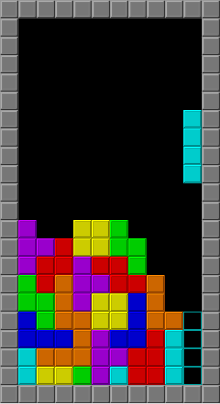Tetris
In the 1980s, Pajitnov worked for the Dorodnitsyn Computing Center of the Academy of Sciences, where he programmed Tetris on the Electronika 60 and adapted it to the IBM PC with the help of Dmitry Pavlovsky and Vadim Gerasimov.
More than 200 versions of Tetris have been published by numerous companies on more than 65 platforms, setting a Guinness world record for the most ports and variants.
[6] Alexey Pajitnov was a speech recognition and artificial intelligence researcher for the Dorodnitsyn Computing Center of the Academy of Sciences.
[14] He felt that the game would be needlessly complicated with the twelve different shape variations of pentominoes, so he scaled the concept down to tetrominoes, of which there are seven variants.
[10] Afterward, he programmed the basic mechanics, including the ability to flip tetrominoes as they fell in a vertical screen and the clearing of lines.
[27] Under Soviet law, intellectual rights were not protected, and the state-run organization Elektronorgtechnica (Elorg) had a monopoly on the import and export of software.
[41] Before releasing Tetris in the United States, the Spectrum HoloByte CEO, Gilman Louie, asked for an overhaul of the graphics and music.
[52] Nintendo was attracted to Tetris for its simplicity and its established success on the Famicom, and considered porting it to their first handheld console, the Game Boy.
[69] In response, the Mirrorsoft owner, Robert Maxwell, pressured the Soviet Union leader, Mikhail Gorbachev, to cancel the contract between Elorg and Nintendo.
[70] Despite the threats to Belikov, Elorg refused to concede, highlighting the financial advantages of their contract compared to those signed with Stein and Mirrorsoft.
[54] Judge Fern M. Smith rejected this argument and declared that Mirrorsoft and Spectrum HoloByte had never received explicit authorization for marketing on consoles.
[54] The next day, Atari Games withdrew its NES version from sale, and thousands of cartridges remained unsold in its warehouses.
[54] In January 1990, Pajitnov was invited by Spectrum HoloByte to the Consumer Electronics Show, and he was immersed in American life for the first time.
[84] In 1991, with Rogers' help, Pajitnov and his family emigrated to Seattle, United States, where he worked as a freelance game designer.
[98][99] David Crookes of Retro Gamer called Tetrisphere "proof that the concept could be modernised and tweaked, while still being faithful to the original".
[88] During this time frame The Tetris Company started to standardize features that were not in the original game in order to appeal to beginner players, according to Rogers.
[5] Critics panned Tetris Worlds for the easy spin mechanic, which allowed players to delay a piece's descent by continually rotating it.
[105] By December 2005 when Electronic Arts (EA) started its acquisition of JAMDAT, Tetris had been consistently selling well on American carrier phones.
In an interview with VentureBeat in June 2014, Maya spoke of her desire to expand Tetris's brand, such as through merchandising, and keeping the game fresh.
[128][129] Tetris Effect was released on the PlayStation 4 on November 9, 2018,[130] and on Windows on July 23, 2019,[131] receiving widespread critical acclaim for its visuals and emotional impact.
Guinness World Records recognized Tetris as the most ported video game in history, with over 200 variants having appeared on over 65 different platforms as of October 2010.
[204] As part of the 2015 inaugural class, The Strong National Museum of Play inducted Tetris into the World Video Game Hall of Fame for its iconic nature.
[77] This success established Nintendo's dominant position in the handheld gaming market, setting a standard that competitors struggled to replicate.
[i] Tetris's cultural impact and recognition is widespread with representation in a vast array of media such as architecture, art, and merchandise.
For example, gameplay techniques such as "hypertapping" and "rolling" have been used to help competitors to maximize their scores beyond level 29, which was previously deemed impossible to complete due to its speed.
Interested in its potential psychological effects based on his experiences playing the game, Pokhilko distributed copies of Tetris to his colleagues at the Moscow Medical Center.
[237] Starting with the research of American psychologist Richard J. Haier in 1992,[238][239][240] Tetris has been frequently used as a form of cognitive assessment and neuroimaging.
[243][244] In 1992, John Brzustowski at the University of British Columbia wrote a thesis on the question of whether or not one could theoretically play Tetris forever.
Thus, if a game with, for example, an ideal, uniform, uncorrelated random number generator is played long enough, any player will almost surely top out.
In 2001, a group of MIT researchers proved that for the "offline" version of Tetris (the player knows the complete sequence of pieces that will be dropped, i.e. there is no hidden information) the following objectives are NP-complete: Also, it is difficult to even approximately solve the first, second, and fourth problem.






